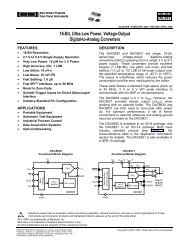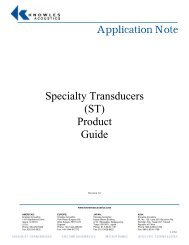AD7714* 3 V/5 V, CMOS, 500 µA Signal Conditioning ADC - dreamm
AD7714* 3 V/5 V, CMOS, 500 µA Signal Conditioning ADC - dreamm
AD7714* 3 V/5 V, CMOS, 500 µA Signal Conditioning ADC - dreamm
You also want an ePaper? Increase the reach of your titles
YUMPU automatically turns print PDFs into web optimized ePapers that Google loves.
CH2–CH0<br />
AD7714<br />
Channel Select. These three bits select a channel either for conversion or for access to calibration coefficients as<br />
outlined in Table VII. There are three pairs of calibration registers on the part. In fully differential mode, the part<br />
has three input channels so each channel has its own pair of calibration registers. In pseudo-differential mode, the<br />
AD7714 has five input channels with some of the input channel combinations sharing calibration registers. With<br />
CH2, CH1 and CH0 at a logic 1, the part looks at the AIN6 input internally shorted to itself. This can be used as<br />
a test method to evaluate the noise performance of the part with no external noise sources. In this mode, the AIN6<br />
input should be connected to an external voltage within the allowable common-mode range for the part. The<br />
Power-On or RESET status of these bits is 1,0,0 selecting the differential pair AIN1 and AIN2.<br />
Table VII. Channel Selection<br />
2<br />
CH2 CH1 CH0 AIN(+) AIN(–) Type Calibration Register Pair<br />
0 0 0 AIN1 AIN6 Pseudo Differential Register Pair 0<br />
0 0 1 AIN2 AIN6 Pseudo Differential Register Pair 1<br />
0 1 0 AIN3 AIN6 Pseudo Differential Register Pair 2<br />
0 1 1 AIN4 AIN6 Pseudo Differential Register Pair 2<br />
1 0 0 AIN1 AIN2 Fully Differential Register Pair 0<br />
1 0 1 AIN3 AIN4 Fully Differential Register Pair 1<br />
1 1 0 AIN5 AIN6 Fully Differential Register Pair 2<br />
1 1 1 AIN6 AIN6 Test Mode Register Pair 2<br />
Mode Register (RS2-RS0 = 0, 0, 1); Power On/Reset Status: 00 Hex<br />
The Mode Register is an eight bit register from which data can either be read or to which data can be written. Table VIII outlines the<br />
bit designations for the Mode Register.<br />
Table VIII. Mode Register<br />
MD2 MD1 MD0 G2 G1 G0 BO FSYNC<br />
MD2 MD1 MD0 Operating Mode<br />
0 0 0 Normal Mode; this is the normal mode of operation of the device whereby the device is performing normal<br />
conversions. This is the default condition of these bits after Power-On or RESET.<br />
0 0 1 Self-Calibration; this activates self-calibration on the channel selected by CH2, CH1 and CH0 of the<br />
Communications Register. This is a one step calibration sequence and when complete the part returns to<br />
Normal Mode with MD2, MD1 and MD0 returning to 0, 0, 0. The DRDY output or bit goes high when<br />
calibration is initiated and returns low when this self-calibration is complete and a new valid word is<br />
available in the data register. The zero-scale calibration is performed at the selected gain on internally<br />
shorted (zeroed) inputs and the full-scale calibration is performed at the selected gain on an internallygenerated<br />
V REF /Selected Gain.<br />
0 1 0 Zero-Scale System Calibration; this activates zero scale system calibration on the channel selected by<br />
CH2, CH1 and CH0 of the Communications Register. Calibration is performed at the selected gain on<br />
the input voltage provided at the analog input during this calibration sequence. This input voltage should<br />
remain stable for the duration of the calibration. The DRDY output or bit goes high when calibration is<br />
initiated and returns low when this zero-scale calibration is complete and a new valid word is available in<br />
the data register. At the end of the calibration, the part returns to Normal Mode with MD2, MD1 and<br />
MD0 returning to 0, 0, 0.<br />
0 1 1 Full-Scale System Calibration; this activates full-scale system calibration on the selected input channel.<br />
Calibration is performed at the selected gain on the input voltage provided at the analog input during this<br />
calibration sequence. This input voltage should remain stable for the duration of the calibration. Once<br />
again, the DRDY output or bit goes high when calibration is initiated and returns low when this full-scale<br />
calibration is complete and a new valid word is available in the data register. At the end of the calibration,<br />
the part returns to Normal Mode with MD2, MD1 and MD0 returning to 0, 0, 0.<br />
REV. B –13–















